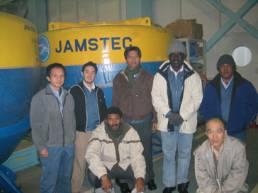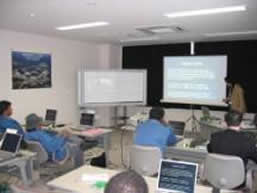Outreach related to fishing activity
In 1998, JAMSTEC has contacted to some Japanese fishing associations and the Japan Ship Owners Association, and asked them to distribute TRITON brochures to ship operating companies. JAMSTEC also asked the Maritime Safety Agency of Japan to announce the exact TRITON buoy locations in the World Cruise Warning System. Similarly, JAMSTEC sent TRITON brochures to fishing associations in Korea, Taiwan, and USA to distribute to ship operating companies. In 1999, JAMSTEC sent representatives to the fishing associations and/or governmental authorities in Korea, Taiwan and Philippine for asking the education to fishing community.
JAMSTEC sent representatives to attend the annual SOPAC (South Pacific Applied Geo-science Commission) meeting since 1997 where TRITON activities were described. The participants understood well the purpose and importance of the TAO/TRITON array and recommended that member countries support efforts to mitigate against fishing related mooring equipment and data loss. SOPAC has also helped to coordinate a number of activities, as described below.
JAMSTEC sent representatives to the FFA (Forum Fisheries Agencies) in 1997. FFA understood well the importance of TAO/TRITON data for research on not only climate change but also fisheries. JAMSTEC requested that FFA will distribute TRITON brochures to ship operators when ships register with FFA before getting fishing licenses from each member state. FFA agreed to distribute the brochures, and also posted the exact locations of TRITON buoys in the FFA Newsletter. JAMSTEC made R/V Mirai visit Honiara, Solomon Island where the FFA headquarters locate, and hold an open house to exhibit the TRITON activities in March 1999.
JAMSTEC sent representatives to the Federated States of Micronesia (FSM) in 1997 to ask permission for year-long clearance for JAMSTEC research vessels in order to maintain TRITON array. This permission was granted. JAMSTEC also asked to charter FSM cargo-passenger vessels for the emergency TRITON operations. This cooperation mechanism was realized in 1999, as the TRITON buoy was successfully restored with the cargo-passenger vessel Caroline Voyager when the tower on the buoy was broken and stopped the data transmission.
JAMSTEC sent representatives to Papua New Guinea in 1998 and 1999 to inform officials there of TRITON activities, and to request help in distributing TRITON brochures.
When TRITON buoys at 0,138E and 2N,138E had troubles of data transmission stop, BPPT, Indonesia coordinated the local authorities and fishing company to enable to send a fishing vessel for those repair operations four times in 1999 and 2000.
JAMSTEC chartered a tag boat Chamorro at Guam in June 2000 to repair the TRITON buoys at 156E and 147E.
JAMSTEC sent a video to relevant fishery associations and authorities to educate fisheries community. The video contents are the TRITON deployment on R/V Mirai, vandalized buoys and buoy data access through TRITON web page.
JAMSTEC hosted training workshops for young marine researchers and engineers from developing island states in regions of the Asia and the western equatorial Pacific Ocean to provide basic scientific and technological knowledge in oceanography and practical exercises in oceanographic observation and handling of these obtained data. Three workshops were organized with the financial assistance of the Nippon Foundation from 2001 to 2002. The participants were from Indonesia, Fiji, Kiribati, Marshall, Micronesia, Nauru, Palau, Papua New Guinea, Philippines Samoa, Solomon, Tuvalu and Vanuatu. JAMSTEC also conducted two similar workshops at SOPAC, in Fiji in 2003, and at JAMSTEC in Japan in 2005. It is anticipated that participants would bring back modern knowledge and technology on ocean observation especially TRITON and ARGO to their homes, and become a core group members for ocean forecasting in their countries and region which would benefit to their countries in developing fisheries industry, promoting tourism as well as contributing to weather forecast.
 |
 |
As above, JAMSTEC paid a lot of efforts to maintain TRITON buoys, however, we encountered number of vandalism on the TRITON buoys in the western Pacific that will make hard to monitor the El Nino. In order to enable sustainable measurements for climate research, JAMSTEC requests further collaboration to reach and educate fisheries community to respect the research buoys.
The TRITON project are supported by the Ministry of Education, Culture, Sports, Science and Technology, Japan.
